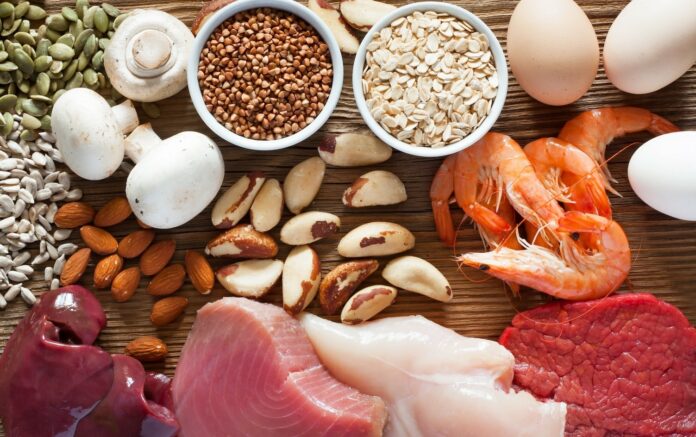Glucagon-like peptide-1 (GLP-1) is a hormone that regulates blood sugar levels. But sometimes, your body may need extra help with the GLP-1 hormone, especially if you have diabetes.
That’s where GLP-1 natural alternatives come into play. They act like sidekicks, lending a hand to support your body’s natural rhythms and keep your blood sugar on track.
While much of the science continues to develop, let’s explore some natural GLP-1 agonists and how they might be able to complement your health journey.
Is There a Natural GLP-1?
The answer is not a simple yes or no—some foods can make you feel fuller longer and slow digestion (like GLP-1 meds do), but they won’t necessarily cause rapid weight loss in the same way—so let’s break it down step-by-step.
- GLP-1 is a hormone naturally produced in the body. The cells in your gut or intestine secrete it to regulate blood sugar levels. It tells your body to produce insulin, which commands your cells to absorb the sugar and produce energy.
- It also slows digestion, makes you feel less hungry, and boosts metabolic health, which can help with weight loss. It conducts the blood sugar orchestra, keeping things in harmony.
- Your body naturally produces enough GLP-1 to keep your blood sugar in check. But if you have diabetes or insulin resistance, it may not be enough.
Diabetes is when your blood glucose levels increase because your body can’t produce or properly use insulin. Cells need insulin to absorb sugar for energy.
Insulin resistance occurs when cells don’t respond well to insulin. Without insulin’s instruction, cells can’t absorb sugar, leading to high blood sugar.
That’s where GLP-1 receptor agonists come in. They mimic the natural GLP-1 hormone and act as reinforcements, improving your body’s GLP-1 levels to control blood sugar. They help stimulate the release of insulin and promote insulin sensitivity.
This allows your cells to absorb glucose and lower blood sugar levels. It also helps keep you full longer and reduces your appetite.
Several GLP-1 agonist medications are available, including:
- Exenatide (Byetta, Bydureon)
- Liraglutide (Victoza, Saxenda)
- Dulaglutide (Trulicity)
- The weight loss drug Semaglutide (Wegovy
But if GLP-1 medications aren’t right for you, you can consider incorporating certain foods into your diet that serve as natural GLP-1 agonists and help with blood sugar control.
According to MyFitnessPal’s Registered Dietitian, Stephanie Nelson, “Changing your diet won’t have the same effects as a GLP-1 medication, but it will help you feel full for longer and slow down your digestion. Also, we are still learning a lot here, so there is more knowledge to come as time goes on!”
Whatever the results of further studies on natural GLP-1 agonists may be, small diet and lifestyle changes has the potential to significantly improve your overall health in the long run.
So, let’s look at some natural ingredients to increase your GLP-1 levels.
Top 5 Foods and Supplements That Could Increase GLP-1 Naturally
Here are some natural GLP-1 agonists to give your body extra support for better blood sugar control:
1. Eggs and protein-rich breakfasts
Recent research indicates that consuming protein and calcium-rich foods for breakfast can enhance GLP-1 release and aid in weight loss efforts. While there’s ongoing research about the potential link between protein-rich foods and GLP-1 release, the evidence is still limited.
Nevertheless, adding protein to your breakfast can offer numerous health benefits. So start your day with eggs and other protein-rich food, regardless of whether they naturally promote GLP-1 release.
Breakfast staples like eggs, milk, peanut butter toast, protein smoothies, quinoa porridge, or Greek yogurt with fruits provide essential nutrients and support healthy living. They may also help regulate blood sugar levels and keep you full longer.
2. Nuts for power-packed snacks
Nuts are delicious, power-packed snacks that enhance a healthy diet. There are claims that nuts boost your GLP-1, but what do we really know?
The evidence is conflicting: Some research shows that nuts increase GLP-1 levels, but another study shows decreased GLP-1 levels after consuming nuts. We need larger studies — done in different groups of people — before we can say for sure whether nuts boost GLP-1.
The good news? Nuts are a great source of protein, healthy fats, and dietary fibers. Eating nuts can boost the quality of your diet, and a healthier diet is associated with weight loss and a healthier weight. So regardless of its impact on your GLP-1, you’re probably going to up your nutrition game by adding nuts to your diet.
3. High fiber grains to stimulate GLP-1 production
Get your daily dose of high-fiber grains to stimulate natural GLP-1 production. Grains rich in soluble dietary fibers — like oats, barley, and rye — may help promote GLP-1 release. They may also help manage blood glucose levels, improve insulin sensitivity, and promote digestive health.
Swapping refined grains with high-fiber whole grains can also help support your weight loss journey and improve overall health.
Many people think they’re meeting the recommended fiber intake when they’re actually falling short. Most adults should aim for 25 grams of fiber daily for women and 38 grams for men.
To get a better picture of how much fiber you’re really getting, use MyFitnessPal to track your food intake. Tracking your food can help you achieve your nutrition goals.
4. Magnesium supplements to stabilize blood sugar levels
Magnesium is an essential mineral with several health benefits. But most importantly, it helps you maintain healthy blood glucose levels. Research done in diabetic rats shows magnesium supplements can boost GLP-1 release, regulate glucose metabolism, and improve insulin sensitivity. But, there’s a lack of research involving human subjects on this matter.
Nevertheless, magnesium remains an essential nutrient with health benefits beyond its potential effects on GLP-1 release. You can boost your dietary magnesium intake by enjoying foods such as spinach, leafy greens, nuts, peas, beans, whole grains, and seeds or taking magnesium supplements.

5. Lean protein to increase GLP-1 and maintain muscle mass
Lean protein — like chicken, fish, and tofu — may be your ticket to elevated GLP-1 levels. Protein-rich foods are loaded with amino acids, which may help stimulate GLP-1 release, maintain muscle mass, and help manage body weight.
Adding lean protein to your meals can possibly enhance your natural GLP-1 levels, stabilize blood sugar levels, and keep your muscles healthy.
The Bottom Line
Enhancing your diet with eggs, nuts, high-fiber grains, magnesium supplements, and lean proteins can support your overall health. These nutrient-rich foods contribute to a balanced diet and potentially hold benefits for supporting GLP-1 release and maintaining a healthy weight.
While we are still learning how exactly these nutrient-dense foods impact your GLP-1, we do know they improve your diet quality and are associated with weight loss and healthy weight, so it doesn’t hurt to work them into your diet.
While food tracking tools like MyFitnessPal can help support you on your wellness journey, the key lies in embracing a holistic approach to health. You can create a sustainable lifestyle that prioritizes your well-being by making mindful dietary choices and incorporating natural GLP-1 alternatives.
Remember that small changes can lead to significant results, whether your goal is to shed a few pounds or simply improve your health. Embrace the journey towards a healthier you, one step at a time.








